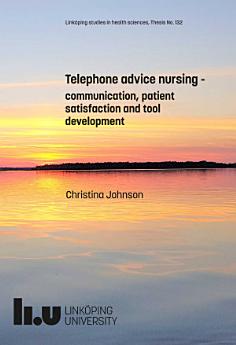Telephone advice nursing: communication, patient satisfaction and tool development
About this ebook
Aims: The overall aim of these two studies was to develop tools to enable improvements and evaluations in communication and interpersonal competence in telenursing from the perspective of both the telenurse and the caller.
Study 1: To develop a self-assessment tool aiming to raise telenurses’ awareness of their communication and interpersonal competence and highlight areas in need of improvement.
Study 2: To develop and assess content validity of a theoretically anchored questionnaire that explores caller satisfaction in TAN as a result of the interaction between the caller and the telenurse.
Methods:
Study 1: The development and the evaluation of content validity of the Telenursing Self-Assessment Tool (TSAT) started with a literature search and domain identification, which were used to generate the items. The assessment of the content validity was performed in two steps. First, an expert group completed two rounds of assessments using Content Validity Index (CVI). Second, telenurses tested the tool and assessed the content validity using CVI. Thereafter, the telenurses participated in consensus discussions. Refinements of the tool were done after every assessment.
Study 2: The development and the evaluation of content validity of the Telenursing Interaction and Satisfaction Questionnaire (TISQ) started with a literature search and domain identification, which were used to generate the items. The assessment of the content validity was performed in two steps. First, cognitive interviews were performed with the callers, the target population. Next, experts evaluated the content validity using CVI. Refinements of the tool were done after every assessment. The Interaction Model of Client Health Behavior (IMCHB) provided theoretical guidance and support.
Results:
Study 1: The TSAT with 58 items was developed. The items were structured according to the nursing process and the tool was judged as having good content validity.
Study 2: The TISQ consisting of 60 items based on the IMCHB was developed. The questionnaire was found to exhibit good content validity.
Conclusions: This thesis describes the development and assessment of content validity of two theoretically anchored tools aimed to improve and evaluate communication and interpersonal competence in telenursing from the perspective of both the telenurse and the caller. The TSAT is meant to create learning opportunities, to provide self-direction, feedback, and coaching, and to guide the telenurse through the nursing process using a person-centred approach. The TISQ aims to explore the callers’ satisfaction and the callers’ perceptions of the interaction with the telenurse. With better knowledge about this, communication improvement and education in telenursing can be tailored to enhance caller satisfaction.



